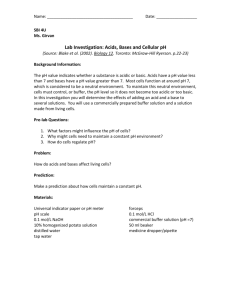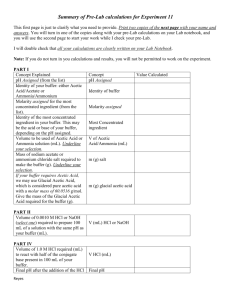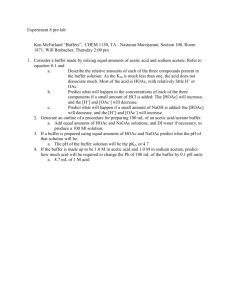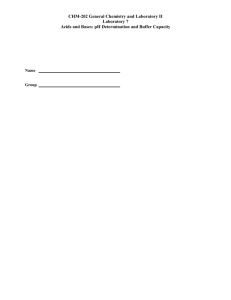pH Properties of Buffer Solutions
advertisement
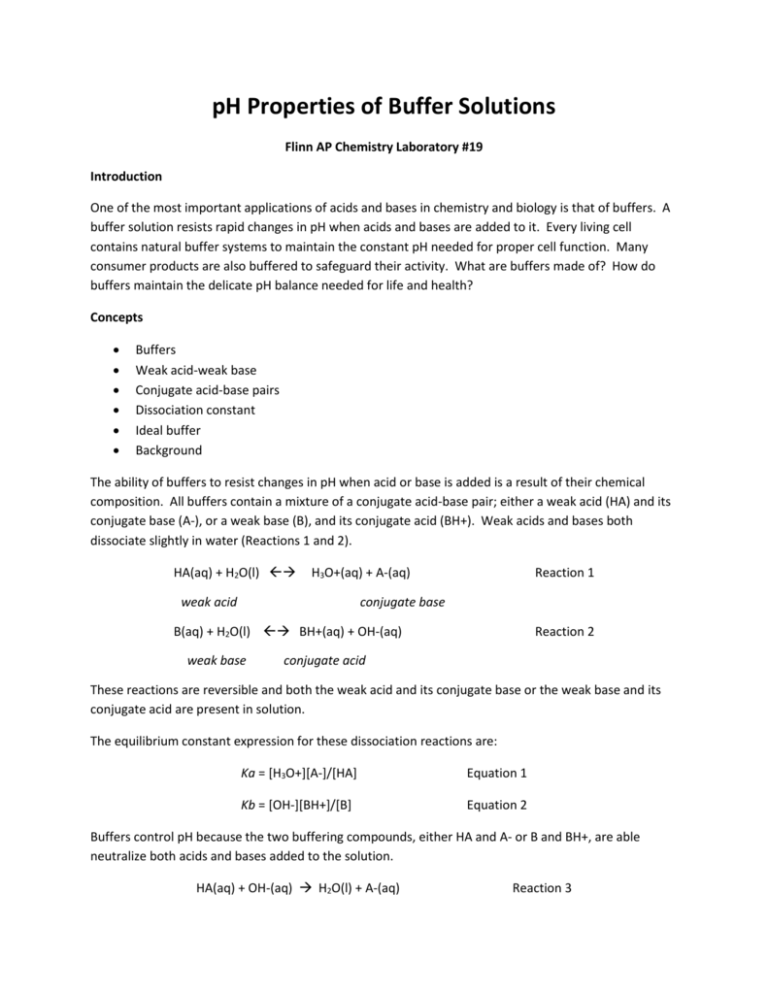
pH Properties of Buffer Solutions Flinn AP Chemistry Laboratory #19 Introduction One of the most important applications of acids and bases in chemistry and biology is that of buffers. A buffer solution resists rapid changes in pH when acids and bases are added to it. Every living cell contains natural buffer systems to maintain the constant pH needed for proper cell function. Many consumer products are also buffered to safeguard their activity. What are buffers made of? How do buffers maintain the delicate pH balance needed for life and health? Concepts Buffers Weak acid-weak base Conjugate acid-base pairs Dissociation constant Ideal buffer Background The ability of buffers to resist changes in pH when acid or base is added is a result of their chemical composition. All buffers contain a mixture of a conjugate acid-base pair; either a weak acid (HA) and its conjugate base (A-), or a weak base (B), and its conjugate acid (BH+). Weak acids and bases both dissociate slightly in water (Reactions 1 and 2). HA(aq) + H2O(l) H3O+(aq) + A-(aq) weak acid Reaction 1 conjugate base B(aq) + H2O(l) BH+(aq) + OH-(aq) weak base Reaction 2 conjugate acid These reactions are reversible and both the weak acid and its conjugate base or the weak base and its conjugate acid are present in solution. The equilibrium constant expression for these dissociation reactions are: Ka = [H3O+][A-]/[HA] Equation 1 Kb = [OH-][BH+]/[B] Equation 2 Buffers control pH because the two buffering compounds, either HA and A- or B and BH+, are able neutralize both acids and bases added to the solution. HA(aq) + OH-(aq) H2O(l) + A-(aq) Reaction 3 A-(aq) + H3O+(aq) H2O(l) + HA(aq) Reaction 4 BH+(aq) + OH-(aq) H2O(l) + B(aq) Reaction 5 B(aq) + H3O+(aq) H2O(l) + BH+(aq) Reaction 6 The actual pH of a buffer solution depends on the concentration of the acid-base pair in solution. If Equation1 is rearranged, the concentration of the hydronium ions in solution is: [H3O+] = Ka x [HA]/[A-] Equation 3 pH = -log [H3O+] = pKa – log ([HA]/[A-]) Equation 4 And the pH is: If the concentrations of the acid-base pair are equal, [HA] = [A-]. The –log [HA]/[A-] is equal to zero, and the pH of the buffer is equal to pKa. By varying the amounts of HA and A- in solution, the pH of the buffer can be changed. For the buffer made up of a weak base (B) and its conjugate acid (BH+), the solution pH calculations are similar. If Equation 2 is rearranged, the concentration of the hydroxide ions (OH-) in solution is: [OH-] = Kb x [B]/[BH+] Equation 5 pOH = -log [OH-] = pKb – log ([B]/[BH+]) Equation 6 And the pOH is: If pOH is known, then pH can be calculated using Equation 7: pH + pOH = 14.00 pH = 14.00 – pOH Equation 7 Once the buffer is made, how does the pH remain constant when strong acid or base is added? Acetic acid is a weak acid, with Ka equals to 1.8 x 10-5. If a buffer solution is made with 0.5 moles of acetic acid and 0.5 moles of its conjugate base sodium acetate, the initial pH of the solution will be equal to pKa, or 4.74. Now, if 0.05 moles of a strong acid is added to the buffer, the H3O+ will react with the 0.05 moles of sodium acetate to form 0.05 moles of acetic acid. This produces a solution with 0.55 moles of acetic acid and 0.45 moles of its conjugate base sodium acetate. If the solution volume change is slight, then the new pH of the solution is: pH = 4.74 – log (0.55/0.45) The pH difference is only 0.09 units! For buffers to be effective, noticeable amounts of both conjugate acid-base pair must be present in solution. This limits the concentration ratios for HA:A- or B:BH+ to between 10:1 and 1:10 and the pH range for the buffering action of any weak acid to pKa +/- 1. An ideal buffer is a solution that contains equal numbers of moles of the conjugate acid-base pair. Experiment Overview The purpose of this experiment is to study the properties of buffer solutions. Two ideal buffer solutions, one consisting of a weak acid and its conjugate base, and the other, a weak base and its conjugate acid, are made. The initial pH of each buffer is determined. Strong acid and strong base are added to each buffer in a series of steps and the pH is determined after each addition. The resulting pH values after each addition will be compared to the calculated pH values for each buffer. Pre-Lab Questions 1. How many grams of sodium acetate (molar mass 82.03g/mol) must be added to 1.00 L of a 0.200 M acetic acid solution to form a buffer of 4.20? Ka value for acetic acid is 1.8 x 10 -5. 2. Three milliliters of a 2.0 M solution of HCl are added to 1 liter of buffer solution containing 0.40 moles of the weak acid, propanoic acid (Ka = 1.4 x 10-5) and 0.50 moles of its conjugate base, sodium propanate. a. What is the original pH of the buffer before the strong acid is added? b. What is the pH of the buffer after the HCl is added? Assume negligible volume change. 3. The weak base-conjugate acid buffer used in this laboratory consists of weak base ammonia,. NH3, and its conjugate acid ammonium chloride, NH4Cl. If the NH3 concentration is 0.05 M and the NH4Cl concentration is 0.05 M, what is the pH of the buffer? Kb = 1.8 x 10-5. Materials Acetic acid solutions, CH3COOH, 0.1 M, 75 mL Beral-type pipets, graduated,4 Buffer solution, NH3, 0.05M, NH4Cl, 0.05M, 100 mL Graduated cylinder, 25 mL Buffer solution, pH 7 Graduated cylinder, 50 mL Hydrochloric acid solution, HCl, 0.2 M, 30 mL Magnetic stirrer and stir bar (optional) Sodium acetate solution, NaCH3COO, 0.1 M, 75 mL Marking pen Sodium hydroxide solution, NaOH, 0.2 M, 30 mL pH sensor or pH meter Water, distilled or deionized Stirring rod Beakers, 50 mL, 2 Wash bottle Beakers, 100 mL, 3 Safety Precautions The acetic acid solution is slightly corrosive. The hydrochloric acid solution is toxic by ingestion and inhalation and is corrosive to eyes, skin, and other tissue. The buffer solution is strongly basic and corrosive to skin, eyes, and other tissue. Avoid contact of all chemicals with eyes and skin. Wear chemical splash goggles and chemical resistant gloves and aprons. Thoroughly wash hands with soap and water before leaving the laboratory. Procedure Part 1. Buffering Properties of a Weak Acid-Conjugate Base Buffer 1. Obtain 25.0 mL of the 0.1M acetic acid solution in a 25-mL graduated cylinder. Transfer the acetic acid solution to a clean 100-mL beaker. 2. Rinse the 25-mL graduated cylinder with deionized water. Obtain 25.0 mL of the 0.1M sodium acetate solution with the 25-mL graduated cylinder. 3. Transfer the sodium acetate solution to the 100-mL beaker containing the 25 mL of the acetic acid solution. Stir the solution. 4. Set-up a pH meter and electrode(or a pH sensor). Calibrate the pH meter using a standard pH 7 buffer solution. 5. Remove the pH 7 buffer solution, place a 100-mL beaker under the electrode, and rinse the electrode with deionized water. 6. Set the 100-mL beaker containing the acetic acid-acetate buffer solution on the magnetic stirrer, if one is available. Add a stir bar to the solution. Gently stir the buffer solution. 7. Place the pH electrode in the solution. Record the pH of the solution in the Part 1 Data Table. (0 mL of the 0.2 M HCl added.) 8. Obtain approximately 30 mL of 0.2 M HCl solution in a clean 50-mL beaker and label the beaker, 0.2 HCl. 9. Using a graduated Beral-type pipet, transfer 1.0 mL of the 0.2 M HCl solution to the acidacetate buffer solution. 10. Record the pH of the solution in the Part 1 Data Table. (1mL of 0.2M HCl added.) 11. Using the same graduated pipet, transfer another 1.0 mL of the 0.2M HCl solution to the acidic acid-acetate buffer solution. 12. Record the pH of the solution in the Part 1 Data Table. 13. Repeat steps 11 and 12, recording the pH in the Part 1 Data Table after each 1.0 mL of HCl is added, until a total of 10.0 mL of HCl has been added to the solution. 14. Remove the electrode from the solution, place a 100-mL beaker under the electrode, and rinse the electrode with deionized water. 15. Dispose of the acetic acid-acetate solution as directed by the instructor, and rinse the 100mL beaker with deionized water. Do not dispose of the HCl. 16. Obtain 25 mL of the 0.1 M acetic acid solution in a clean 25-mL graduated cylinder. Transfer the acetic acid solution to the rinsed 100-mL beaker. 17. Rinse the 25-mL graduated cylinder with deionized water. Obtain 25.0 mL of the 0.1 M sodium acetate solution in the 25-mL graduated cylinder. 18. Transfer the sodium acetate solution to the 100-mL beaker containing 25 mL of the acetic acid solution. Stir the solution. 19. Place the 100-mL beaker on the magnetic stirrer. Add a stir bar and gently stir the buffer solution. 20. Place the pH electrode in the solution. Record the pH of the solution in the data table. ( 0 mL 0f 0.2 M NaOH added.) 21. Obtain approximately 30 mL of0.2 M NaOH solution in a clean 50-mL beaker. Label the beaker, 0.3 M NaOH. 22. Using a clean graduated Beral-type pipet, transfer 1.0 mL of the 0.2M NaOH solution to the acetic acid-acetate buffer solution. 23. Record pH of the solution in the Part 1 Data Table. 24. Repeat steps 22 and 23, recording the pH in the data table after each 1.0 mL of NaOH solution is added, until the total of 10.0 mL of NaOH has been added. 25. Remove the pH electrode from the solution, place a 100-mL beaker under the electrode, and rinse the electrode with deionized water. 26. Dispose of the acetic acid-sodium acetate solution as directed by the instructor, and rinse the 100-mL beaker with deionized water. Do not dispose of the NaOH solution Part 2. Buffering Properties of a Weak Base-Conjugate Acid Buffer 1. Obtain 50 mL of the ammonia-ammonium chloride buffer solution in a 50-mL graduated cylinder. 2. Transfer the 50 mL of buffer solution to a clean 100-mL beaker. 3. Set the 100-mL beaker on the magnetic stirrer. Add a stir bar to the solution. Gently stir the buffer solution. 4. Place the pH electrode in the solution. Record the pH of the solution in the Part 2 Data Table. (0 mL of 0.2 M HCl added.) 5. Using a clean graduated Beral-type pipet, transfer 1.0 mL of the 0.2 M HCl solution to the ammonia-ammonium chloride buffer solution. Record the pH in the Part 2 Data Table. 6. Repeat step 5, recording the pH in the Part 2 Data Table after each 1.0mL of HCl added, until a total of 10.0 mL of HCl has been added. 7. Remove the pH electrode from the solution, place a 100-mL beaker under the electrode, and rinse the electrode with deionized water. 8. Dispose of the ammonia-ammonium chloride solution as directed by the instructor, and rinse the 100-mL beaker with deionized water. 9. Obtain another 50 mL of the ammonia-ammonium chloride buffer solution in a clean graduated cylinder. 10. Transfer the 50 mL of buffer solution into the rinsed 100-mL beaker. 11. Set the beaker on a magnetic stirrer. Add a stir bar to the beaker and gently stir the buffer solution. 12. Place the pH electrode in the solution. Record the pH of the solution in the Part 2 Data Table. (0 mL of 0.2M NaOH added.) 13. Using a clean graduated Beral-type pipet, transfer 1.0 mL of the 0.2 M NaOH solution to the ammonia-ammonium chloride buffer solution. Record the pH in the Part 2 Data Table. 14. Repeat step 13, recording the pH in the Part 2 Data Table after each 1.0mL of NaOH added, until a total of 10.0 mL of NaOH has been added. 15. Remove the pH electrode from the solution, place a 100-mL beaker under the electrode, and rinse the electrode with deionized water. 16. Dispose of the ammonia-ammonium chloride solution as directed by the instructor. Part 3. Preparation of a pH 5.00 Buffer solution 1. Calculate the correct volumes of the 0.1 M acetic acid and the 0.1 M sodium acetate solutions needed to make a 50 mL of a buffer solution with a pH value of 5.00. Record these amounts in the data table, Ka= 1.8 x 10-5. 2. Obtain the calculated volume of the 0.1M acetic acid solution in a clean 50-mL graduated cylinder and transfer this volume to a clean 100-mL beaker. 3. Rinse the graduated cylinder with deionized water. Obtain the calculated volume of the 0.1 M sodium acetate in the graduated cylinder and transfer the volume to the 100-mL beaker containing the acetic acid solution. Stir the solution. 4. Place the beaker under the pH electrode. 5. Place the pH electrode in the acetic acid-sodium acetate buffer solution. Record the pH in the Part 3 Data Table. 6. Remove the electrode from the solution, place a 100-mL beaker under the electrode, and rinse the electrode with deionized water. 7. Dispose of the acetic acid-acetate buffer solution as directed by instructor. 8. Store and put away the pH electrode as directed by the instructor. 9. Disposal 10. Dispose of all solutions as directed by the instructor. Data Tables Part 1. pH of Acetic Acid-Sodium Acetate Buffer mL of 0.2 M HCl added 0 1.0 2.0 3.0 4.0 5.0 6.0 7.0 8.0 9.0 10.0 pH actual pH Calc. mL of 0.2 M NaOH added 0 1.0 2.0 3.0 4.0 5.0 6.0 7.0 8.0 9.0 10.0 pH actual pH Calc. mL of 0.2 M NaOH added 0 1.0 2.0 3.0 4.0 5.0 6.0 7.0 8.0 9.0 10.0 pH actual pH Calc. Part 2. pH of Ammonia-Ammonium Chloride Buffer mL of 0.2 M HCl added 0 1.0 2.0 3.0 4.0 5.0 6.0 7.0 8.0 9.0 10.0 pH actual pH Calc. Part 3 mL of 0.1M CH3COOH _______________ mL pH __5.00____ (calc.) mL of 0.1M NaCH2COOH_______________ mL pH _______________ (calc.) Calculations 1. Using Equation 4,calculate the pH of the Part 1 acetic acid-sodium acetate buffer solution before and after 1.0 mL of 0.2M HCl solution is added to the buffer. Ka of the acetic acid equals 1.8 x 10-5. Enter these values in the Part 1 Data Table. 2. Repeat the pH calculations for each successive 1.0 mL increment of 0.2 M HCl added to the buffer. Enter these values in the Part 1 Data Table. 3. When strong base is added to a buffer of a weak acid-conjugate base, the acid reacts with the base to form water and its conjugate base. HA (s) + OH-(aq) H2O(l) + A-(aq) 4. Calculate the pH of the Part 1 acetic acid-sodium acetate buffer solution after 1.0 mL of the 0.2 M NaOH solution is added to the buffer. Enter these values in the Part 1 Data Table. 5. Repeat the pH calculation for each successive 1.0 mL increment 0.2 M NaOH added to the buffer. Enter these values in the Part 1 Data Table. 6. The ammonia-ammonium chloride buffer solution is a weak base-conjugate acid buffer solution. Kb for NH3 equals 1.8 x 10-5. Using Equation 4 and the relationship; pH = 14.0 – pOH 7. Calculate the pH of the ammonia-ammonium chloride buffer solution after 1.0 mL of the 0.2 M HCl is added to the buffer solution. The initial moles of both NH3 and NH4Cl in 50 mL of the buffer solution are 0.0025 moles. Record the pH value in the Part 2 Data Table. NH3(aq) + H3O+(aq) NH4+(aq) + H2O(l) 8. Repeat the pH calculation for each successive 1.0 mL increment of 0.2 M HCl added to the buffer. Enter these values in the Part 2 Data Table. 9. Repeat the pH calculations for each 1.0 mL increment of 0.2 M NaOH added to the ammoniaammonium chloride buffer solution. Enter these values in the Part 2 Data Table. Post-Lab Questions 1. Calculate the pH change when of 1 mL of 0.2M HCl is added to 50 mL of deionized water. How does this pH value change compared to those obtained when 1 mL of 0.2 M HCl is added to the buffers? 2. At what point did each of the buffers lose their effectiveness? Explain.




